Maps. Essential? Not essential now that savnavs and gps exists? Not essential but interesting?
Or perhaps, possibly, fascinating.
Maddy wanted to do some geography. She wasn’t sure what geography and i don’t particularly thrive on being handed a “subject” to just DO, like that, so i suggested we start with a couple of books. And both books started with maps.
So maps was what we did.
Maddy quite likes a workbook and she REALLY likes the CGP books, because the pages of text and workbook correlate, which appeals to her, and they are threaded with silly jokes, which she finds hilarious. So starting off on a run of using that book was altogether fine by her. It’s a KS2 book and she’s in the middle of KS2 (supposedly) so that ought to be about the right level.
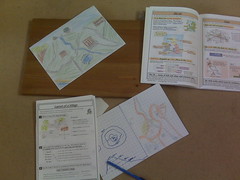
The books threw up a few interesting points, and then i suggested she might like to draw an imaginary world that we could make a map of. We talked about various physical and human features and made quite a list in our heads about it all; lakes, ponds, beaches, hill, mountains, parks, woods, villages, roads, churches.
But i forgot an important thing – and it is one of the reasons i am so passionate about HE and all it stands for and one of the reasons i know school is so very wrong for me and my child. Maddy has Aspergers, high functioning Aspergers no less, which means she is, and appears, very clever, very thoughtful, very together and fully able to keep up with what is going on.
But actually, Maddy is a clue finder who hunts through peoeples faces and voices to try and second guess the reaction they want and she isn’t very good at all at doing things that haven’t come out of her head. She’s exceptionally creative, very good at making things, very good a teasing a project out of thin air – but she likes them to come from her head. She’s my most pro-active child, always got something on the go, always making things, always seeing a project in amongst the recycling or from CBBC or a book or whatever. But ask her to translate something from someone else’s head and she goes into meltdown. What she does is fix on a couple of words she hears, translates it into something she can relate to and smiles and nods at you while you think she has followed what you asked her to do.
What she fixed on in this instance was the word map and the word world – and so because worlds are circular and have countries, she drew a globe face with a series of shapes on it that were countries. No lakes, no mountains, no any of those things we’d talked about. She also heard the word map, so she overlaid all this with a grid and a compass on the side. Which was all very well (not really actually because she had neither created a world or a map but a strange hybrid of the two) but it left us without a path forward in what i had planned to do with her.
So we discussed it all again, came up with more ideas, talked about drawing it, talked about what we were going to do next with it and she went off, nodding and smiling, to try again.
Only she went and hid under her bed and cried. Because Maddy is a visual learner and she doesn’t really compute that you might not have in your head what she has in hers and she can’t overwrite her vision with your words – in fact, the vision crowds out the sound of the words and mixes them into a kind of dyslexic jumble in her head.
Now i’m her mum and we’ve been working on this skill for years and i can only tell you she is better than she used to be – and i’m also able, after the second attempt hasn’t worked, to say “here Maddy, let me draw you an example”. Once i’d done that, to rescue a fast collapsing project, she was away and produced the drawing you can see above.
You might say, advocating school, that all this mollycoddling is no good at all and SHE’S GOT TO LEARN, DAMMIT – to which i say, simply, we are all different. Yes, she is going to have to acquire some form of this skill eventually, in the same way some of us learn to be great mathematicians and some of us learn to do the right sum to work out how much VAT to add on. She might not need to learn it too hard though, she might not even have to learn it much at all. But she certainly does need to learn that when it’s hard to listen, it gets all the harder if you collapse in a wailing heap of panic. And that’s what we’re working on right now. Maddy would quite like to be an artist/cartoon animator/set designer/clothing designer. She might get away quite nicely without too many listening skills in some of those jobs, but i’m confident she is going to need some to make the alterations people will ask of her. She’s only 9 though; not much point in panicking yet. And if i can teach her, through slow and steady patience, that the words make sense if only you can hear them, then i think she’ll be okay.
So anyway, we navigated that problem okay and moved on to how we might turn this drawing into a map.
We talked about hills – and we made one, with her favourite, entirely non-threatening orange blanket.
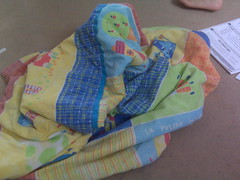
(No orange blankets were harmed in the making of this mini project.)
We talked about contour lines, height and the fact that hills are not conical and we got out a map of Dartmoor to see how they were drawn there.
We made a hill of waste Fimo, marked some pretend heights up one side of it and then cut it into slices, drawing round each of the to make some contour lines that described our “hill”.
We spent a very, very long time in the entirely non-threatening environment of my double bed, with a map of our local area out (definite absence of hills!), poring over the key, looking for landmarks and finding roads we know to see what colour they were, so we could decide what type of roads Maddy’s fictional ones might be.
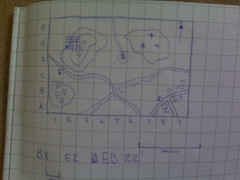
We discussed how we might give directions using a map and explored the idea of grid references. Again, Maddy got panicky because i, daftly, said “imagine i want you to find a letterbox (old style geo cache) in a church – how will you know which of the three churches to go to?” and she fixated on the idea of a sensible place to put a letterbox (must be the church on a hill, because we go letterboxing on hills) instead of the idea we had just spent 10 minutes talking about. But because we have time, because i know her, i could say not only “no, we’re talking about grid references!” but also, “Maddy, try to step back from that one word that confused you and see the whole question” – it’s slow, it’s painful, but if you could have known the confused little soul she was at 3 years old, you’d know it was progress.
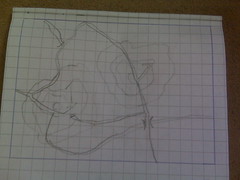
There were more tears about her final draft – because it wasn’t going to be perfect.
We talked about those references a bit more, about how, in fact, it is okay to make up something to suit what you have to work with – and we divided one little box up into 36 tiny boxes and created our own code for finding which of those our imaginary letterbox was in (and idea that was no longer a red herring… oh god, don’t mention red herrings or we’ll have to move to the fictional river…)
After that we moved on to the idea of a scale for the map and using the map i had drawn, we tried to work out what would make sense. We tried 4 squares to 1kn and 1 square to one km and i knew she had got it, not because she launched into complicated sums or filled in a worksheet, but because she put a dot on the map and said that if we were using one scale that would be a fairy and if we used the other, it would be a giant.
Personalised education, you see?
Lastly we did the compass, the thing that originally so completely summed up a map for her. We talked about single arrows, about the assumption that up was north and why you might alter that, about big artistic compasses on old maps. And she settled on an arrow. But as you can see from the picture, even though it couldn’t possibly make a difference, she had to go and get her own little compass to have on one side while she did it.

Because that is how Maddy works – and i’ll bet you a dollar to a dime, sat in a classroom doing this, she’d have fretted away and would have needed to take her compass in the next day to show her teacher and put it next to the map that she’d have needed to get out, just to finish in her mind how it should have been.
Only there might not have been the time or opportunity – and that would have hurt her all the way to her inside.
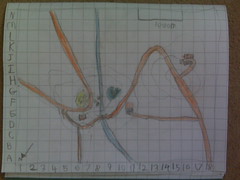
She was very pleased with the end result – we’ve covered a lot. Maths, geography, so history, some art, some very valuable life skills and discussions about current and future technology, some vital coping with things that stretch you skills. We’ve done it over several days and now we are going to do more – there is a plan for a model and some land and water form cards and models – and after that we’ll possibly branch out again.
In fact today we reverted to the workbook – she liked a piece about a developing village very much and we explored that for a while, including a long discussion about the effect of a bypass on a village overloaded with traffic. We’ve got an excellent example of that nearby, Thorney, which recently got a long needed bypass. We spent ages on Google Maps looking at that, relating it to the work book and we’re going to go on a field trip there shortly. We’ll probably mix it up with a visit to the Abbey at the same time. And we might even have ice-cream. Being home educated sucks 😉




You are a fantastic mum and a great teacher – I really wish I could do this too but it’s not in my nature to ‘not conform’ so school it is for the time being…
aw, Merry, that’s lovely. And yes, it proves the point really that you can’t plan a full year’s worth of education in advance really!
another fab post, I can ‘see’ the huge progress Maddy has made, well done done to you both.
I’m so glad you said towards the end, that you had worked on this over a few days, i was begining to think, how on earth did you fit that all into one day 😉
Ditto tbird’s comment.
Merry, you’ve just described how my Ben appears to tick and therefore you’ve helped me out big time. That’s a lovely post, thanks for sharing it.
That was fantastic Merry! It proves how things naturally unfold given opportunity and the right environment.
I’m so glad that Maddy and you are learning from each other. Yes, it would be an unusual school that could adapt itself to fit her properly.
Is a map something like what you see out of the window or looking down from a hot air balloon, or is it description of what’s next to or connected to what? (I think it’s both, depending on the circumstance). For instance http://www.visualcomplexity.com/vc/blog/?p=505.
When you’re on the global scale and you want a flat map, what do you think is most important? Shape and bearings between things (the Mercator projection: http://en.wikipedia.org/wiki/Mercator_projection) or area (http://en.wikipedia.org/wiki/Gall-Peters_projection). Does size relate to importance?
Then there’s the here-be-dragons nature of maps being developed over time. Browse around http://www.openstreetmap.org/ enough and you find some interestingly sketchy bits of the UK. Who makes maps and why? (Armies, like the Ordnance Survey, miners like John McDouall Stuart etc.).
I think that Dwarfish maps in Middle Earth stories have East going up, BTW.
Yes, another way in which I’m turning into my dad (raving about maps)!
I’m a visual learner too, so can totally relate to this – I just wish I’d had a Mum like you to home educate me when I was a child, it would have made life so much easier! As it was I spent years telling people “don’t tell me, show me. I can’t follow the words but if you show me I’ll get it straight away”. At one point I gave serious thought to having a t-shirt printed as I got so sick of explaining this to the same people over and over :o/
My favourite thing about home education is that you really get to understand how your child thinks and can provide the kind of education they couldn’t possibly get anywhere else.